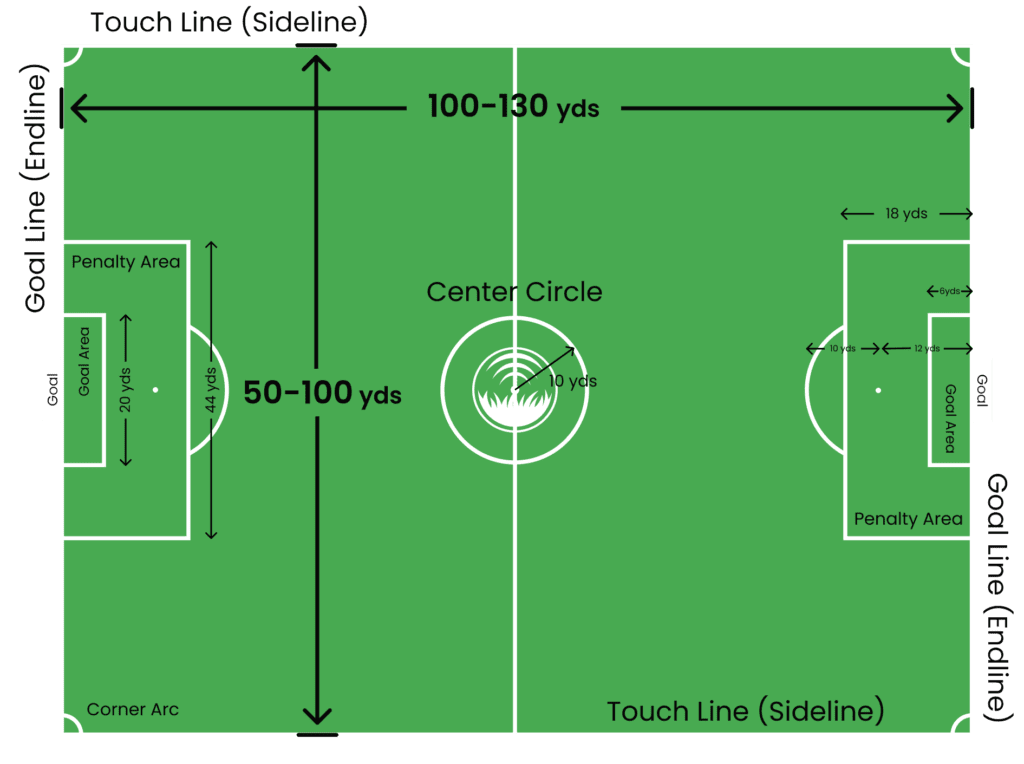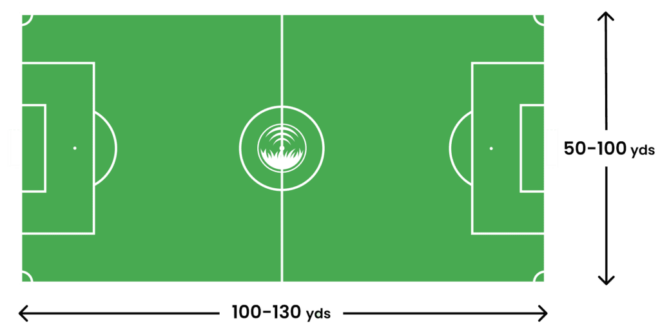A soccer field, also known as a football pitch, is typically between 100 and 110 meters in length. The length varies depending on the level of play and the governing body.
Welcome to the dynamic world of soccer, a sport played on a rectangular grassy field that is not just a mere playing surface but a canvas where athletic prowess is showcased. The length of this field plays a crucial role in the game, as it can influence the pace and style of play.
FIFA regulations stipulate that the optimal size ensures fairness and quality. Enthusiasts and players alike understand that proper field dimensions are integral to the sport’s integrity. As teams battle for supremacy on fields around the globe, the measurements set by authorities ensure a consistent and thrilling soccer experience for players and fans. With such specifications in place, soccer continues to be a universally cherished sport, bringing together communities with its blend of strategy, skill, and physicality.

Table of Contents
The Standard Soccer Pitch
A soccer pitch is where all the magic happens in this beautiful game. It’s a place of victory, defeat, teamwork, and skill. FIFA, the sport’s governing body, sets strict guidelines for pitch dimensions. This ensures consistency across the world. Fans and players alike cherish the standard field as the stage for sporting excellence.
Fifa Regulations
The official rules set by FIFA guarantee a level playing field, literally. They outline specifics for length, width, and other features. Every organized match must follow these standards. FIFA’s pitch dimensions make sure games are fair and consistent.
Dimensions For International Matches
At the highest level, soccer fields must meet precise measurements. Especially for international matches. Fields range in length from 100 to 110 meters. Their width varies between 64 and 75 meters. This size makes room for world-class play. Here’s what that looks like:
| Feature | Minimum Size | Maximum Size |
|---|---|---|
| Length | 100 m (110 yds) | 110 m (120 yds) |
| Width | 64 m (70 yds) | 75 m (80 yds) |
Professional soccer thrives on this stage. It also inspires young players everywhere. Whether it’s a local park or a grand stadium, the dimensions stay true to FIFA’s vision. So next time you watch a game, remember the thought behind every blade of grass that creates the perfect pitch.
Variations Across Leagues
Soccer enthusiasts often discuss the dynamic nature of the sport. One aspect that frequently sparks interest is the variation in soccer field lengths across different leagues. An understanding of these variations is crucial for fans and players alike.
European Vs. American Fields
The size of soccer fields can differ notably between Europe and America. European soccer, particularly under UEFA regulations, often sees larger pitches. This aligns with international standards set by FIFA, which mandate a length ranging from 100m to 110m and a width from 64m to 75m for international matches. European fields usually stick close to these maximum dimensions to accommodate a wide-ranging style of play.
American soccer fields tend to vary more widely. Major League Soccer (MLS) fields sometimes fall on the smaller end of FIFA’s spectrum. This can influence match dynamics, making the games faster and potentially more frenetic. It reflects the American style, where physicality and pace are highly valued.
Youth And Amateur Field Sizes
Youth soccer matches and amateur leagues further illustrate the differences in field sizes. Smaller fields are the norm here to suit the players’ age and skill level. For instance, a field for players under 12 may range from 45m to 60m in length, and from 35m to 45m in width. As players grow, so do the field dimensions.
Youth leagues follow these modified sizes to enhance the playing experience. It allows for more touches on the ball and helps in the development of young players’ skills. Amateur fields also adjust to accommodate space limitations or the number of players on a team.
| Age Group | Length (meters) | Width (meters) |
|---|---|---|
| Under 12 | 45 – 60 | 35 – 45 |
| 12-14 | 60 – 75 | 45 – 55 |
| 14-16 | 75 – 90 | 55 – 65 |
| 16 and over | 90 – 120 | 45 – 90 |
Importance Of Field Size
Soccer field size matters a lot in the game. Different sizes change how the game feels and flows. Players on a bigger pitch run more and the game can look different. The smaller field makes the game faster and more intense. Rules set a range for soccer field sizes. This makes sure games are fair but still unique.
Impact On GamePlay
Field size affects soccer in many ways.
It shapes how teams form their strategy and play. Here’s why field size matters:
- Larger fields: More space for players to run around.
- Smaller fields: Players must think and act quickly.
Teams might choose to pass more on big pitches. On small ones, they may go for quick shots. This shows why field size changes the way soccer is played.
Home Advantage Explained
Home teams know their field’s size. They get used to it. This helps them plan better. Here’s more on home advantage:
| Home Advantage Factor | How It Helps |
|---|---|
| Familiarity | Teams know their field’s quirks. |
| Strategy | They can make game plans that fit their field. |
| Preparation | Practicing in their field helps them get ready. |
Field size makes home games special. It’s part of the home team’s edge.

The Making Of A Soccer Field
The Making of a Soccer Field is an intricate process that transforms a mere piece of land into a vibrant stage for the world’s most beloved game. Precision in size and attention to detail are essential for creating a field that not only meets professional standards but also inspires the athletes who play on it and the fans who watch the games unfold.
Materials And Turf Types
When creating a soccer field, choosing the right materials is crucial. Fields can vary in terms of the surface players will encounter. Two common turf types stand out:
- Natural Grass: Traditional and widely preferred, offering a soft and natural playing surface.
- Artificial Turf: Durable and low-maintenance, it provides a consistent playing field in all weather conditions.
| Material | Pros | Cons |
|---|---|---|
| Natural Grass | Eco-friendly, optimal for play | Requires more upkeep |
| Artificial Turf | Lesser maintenance | Can get hotter than natural grass |
Maintenance Requirements
Maintaining a soccer field is just as important as its initial creation. Regular care ensures the pitch remains playable and safe. Here are key maintenance tasks:
- Mowing: Natural grass fields need frequent cutting to remain even and playable.
- Watering: An irrigation system keeps the turf healthy and resilient.
- Aeration: This allows the soil to absorb more nutrients and water.
Artificial fields also need attention. Regular cleaning and brushing maintain the integrity of the synthetic fibers and keep the surface in top condition.
Lines And Markings
The pitch’s layout is essential for the flow of a soccer game. The lines and markings on a soccer field create a map that players and officials follow. Each line carries its significance and governs the rules of the game. Not only do they mark boundaries, but also define key playing zones. Let’s explore some crucial areas demarcated by these lines and their functions within the game.
The Penalty Area
At each end of the field, the penalty area is critical. It measures 18 yards from the goal line. This zone is crucial for both attack and defense. Goalkeepers can use their hands here, but only within this area. All fouls by the defending team result in a penalty kick from 12 yards out. Knowing the dimensions and rules of the penalty area can influence the outcome of a game.
| Feature | Function |
|---|---|
| Penalty Spot | Where penalty kicks are taken. |
| Goal Area | Where goal kicks are taken. |
| Penalty Arc | Marks exclusion zone for players during penalties. |
Importance Of The Center Circle
The center circle is emblematic of fairness and the start of play. This circle has a radius of 10 yards from the center mark. Only the kicker and the opposing goalkeeper can be in the center circle during kick-off. This rule ensures everyone starts at an equal distance from the ball. This space also helps in managing free kicks. All opposing players must stand outside the circle during a kick-off. This allows the team in possession a fair start.
- Tipoff point: Kick-off starts here at match beginning, after half-time, and following goals.
- Respect distance: Opponents must keep the 10-yard distance on kick-offs and certain free kicks.
- Guiding players: The circle helps players judge distances during set pieces.
Stadiums With Notable Dimensions
The size of a soccer field can greatly influence the game. Fields may vary in size but remain within international guidelines. Here, we explore some remarkable stadiums known for their impressive and unique dimensions.
Largest Soccer Venues
Soccer stadiums with the largest pitch areas stand out globally. They also offer incredible atmospheres due to their vast seating capacities.
- Rungrado 1st of May Stadium – North Korea: To date, this is the world’s largest by seating, accommodating over 114,000 fans.
- Michigan Stadium – USA: Nicknamed “The Big House,” this venue can hold 107,601 spectators and has hosted significant soccer events.
- Estadio Azteca – Mexico: An iconic venue that has hosted two FIFA World Cup finals, it has space for 87,523 attendees.
We see that the magnitudes of these stadiums contribute to their fame and the unforgettable experiences they offer.
Unique Stadium Features
Some stadiums garner attention not just for their size, but for distinct characteristics.
- Estadio Hernando Siles: Situated at 3,637 meters above sea level in La Paz, Bolivia, it challenges even the fittest players with its altitude.
- Stadion Gospin Dolac: In Croatia, this stadium boasts a stunning backdrop of cliffs and lies adjacent to a precipice.
- Ottmar Hitzfeld Stadium: Found in Switzerland, it claims the title of the highest football stadium in Europe at 2,000 meters above sea level.
These stadiums provide soccer with exceptional settings that leave players and fans alike in awe.
Future Trends In Field Design
The landscape of soccer, a sport cherished globally, is ever-evolving. Not just in how the game is played, but where it’s played. Future Trends in Field Design mirror this dynamic evolution.
They showcase a blend of innovation, sustainability, and entertainment. Let’s explore these trends.
Technological Advances
As technology seeps into every aspect of our lives, soccer fields are no exception. Futuristic pitches may soon feature innovations such as:
- Hybrid turfs: Combining natural grass with synthetic fibers for durability and year-round play.
- LED under-lighting: Customizable patterns and messages to engage fans and enhance the visual experience.
- Augmented reality: Interactive displays for live stats and analyses, transforming spectator experiences.
Sustainable Practices
As environmental concerns take center stage, soccer field design is not left behind. Sustainability drives innovations with:
- Water conservation: Integrated systems to collect and reuse rainwater for field irrigation.
- Renewable energy: Fields powered by solar panels or wind turbines, reducing carbon footprints.
- Eco-friendly materials: Use of recycled and non-toxic substances in field construction.

Player Perspectives
As the whistle blows and cleats tread the lush soccer pitch, every player feels the space differently. The length of the field sets the stage for the game’s tempo and strategy. From the sprinting forward to the steadfast goalkeeper, each experiences the pitch in unique ways. Let’s delve into the world from their vantage points and explore how field dimensions impact their play.
Professional Insights
Experienced players know that field length can drastically influence a match. Top-tier athletes often comment on how the size of the pitch affects their performance. A longer field may advantage teams that excel in endurance and long passes. Conversely, a shorter pitch could benefit squads with tight ball control and quick passing skills. The dimensions directly interact with a team’s tactics, shaping the flow and outcome of the game.
Adapting To Different Fields
Soccer fields are not all cut from the same cloth. Variations exist within set ranges. Players must quickly adapt to these differences. Adaptability becomes key. Midfielders, for instance, might need to adjust their passing ranges. They also conserve energy on a smaller field. Defenders, on the other hand, face more pressure with less space to cover. This can lead to a more aggressive style of play.
Goalkeepers adapt as well. With longer fields, they have more time to react to long-range shots. On shorter fields, they must be vigilant against quick attacks. A player’s ability to adjust often separates the good from the great.
Frequently Asked Questions Of Soccer Field Length
What is a regulation of Soccer field length?
A regulation soccer field for international matches is typically between 100 meters (110 yards) and 110 meters (120 yards) in length. However, fields may vary in length for different levels of play.
How wide is a standard Soccer field?
Standard soccer fields have a width ranging from 64 meters (70 yards) to 75 meters (80 yards), complying with the FIFA guidelines for international match play.
Can Soccer fields vary in size?
Yes, soccer fields can vary in size to accommodate different levels of play. The minimum dimensions for adult soccer are 100×50 meters, while the maximum is 110×75 meters according to FIFA regulations.
What’s the length of a youth Soccer Field?
Youth soccer fields are smaller, ranging in length from approximately 55 meters (60 yards) to 80 meters (87 yards), depending on the age group and league requirements.
Conclusion
To wrap things up, knowing the dimensions of a soccer field is crucial for players, coaches, and fans alike. Adherence to regulation length ensures fair play and proper training. Let these insights on soccer field measurements guide you, whether you’re preparing for a game or planning a facility.
 SMGB TODAY Sports, Movies, TV Shows
SMGB TODAY Sports, Movies, TV Shows

